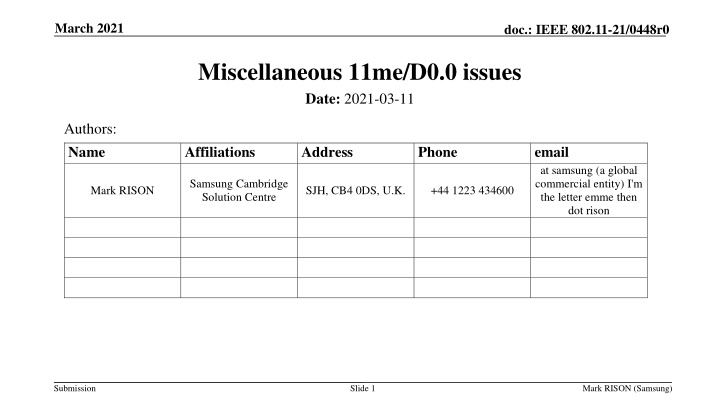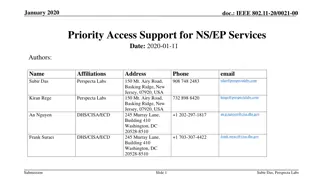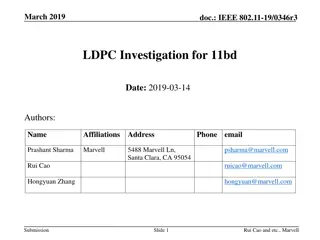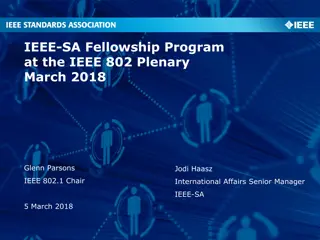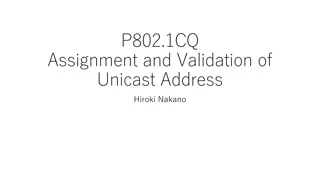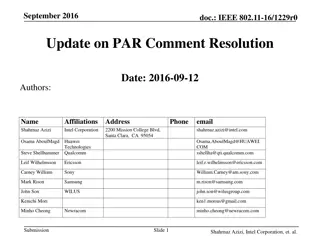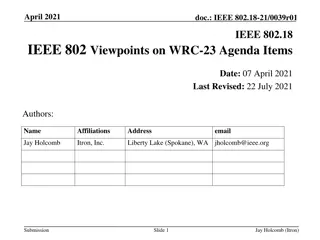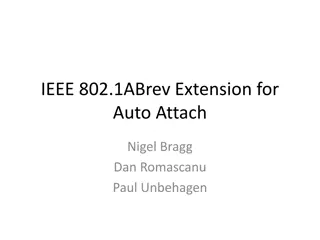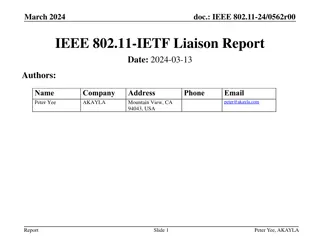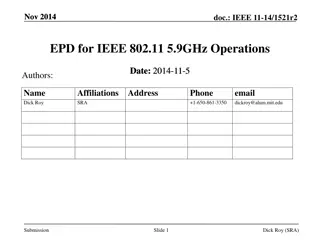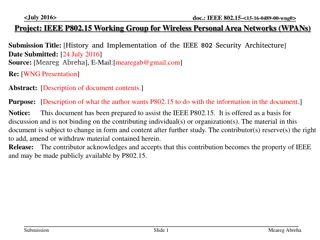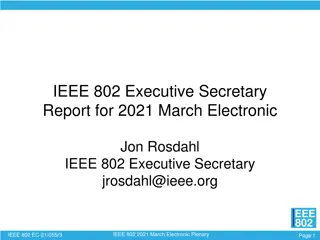IEEE 802.11-21/0448r0 Miscellaneous Issues Examined in March 2021
This submission delves into various miscellaneous points left over from REVmd, addressing issues related to QoS data frames in IEEE 802.11 standards. The author provides insights and proposed resolutions for ambiguous terminology and interpretations within the specifications. In particular, the discussion revolves around clarifying the definition and usage of QoS data frames, aiming to enhance the understanding and consistency in the standards.
Download Presentation

Please find below an Image/Link to download the presentation.
The content on the website is provided AS IS for your information and personal use only. It may not be sold, licensed, or shared on other websites without obtaining consent from the author.If you encounter any issues during the download, it is possible that the publisher has removed the file from their server.
You are allowed to download the files provided on this website for personal or commercial use, subject to the condition that they are used lawfully. All files are the property of their respective owners.
The content on the website is provided AS IS for your information and personal use only. It may not be sold, licensed, or shared on other websites without obtaining consent from the author.
E N D
Presentation Transcript
March 2021 doc.: IEEE 802.11-21/0448r0 Miscellaneous 11me/D0.0 issues Date: 2021-03-11 Authors: Name Affiliations Address Phone email at samsung (a global commercial entity) I'm the letter emme then dot rison Samsung Cambridge Solution Centre Mark RISON SJH, CB4 0DS, U.K. +44 1223 434600 Submission Slide 1 Mark RISON (Samsung)
March 2021 doc.: IEEE 802.11-21/0448r0 Abstract This submission examines various miscellaneous points left over from REVmd. Submission Slide 2 Mark RISON (Samsung)
March 2021 doc.: IEEE 802.11-21/0448r0 QoS Data frame Per CID 4259 in REVmd: "QoS Data frame" is ambiguous. It could mean Type = Data, Subtype has b7 set, or it could mean Type = Data, Subtype = QoS Data In some parts of the spec, QoS Data clearly just refers to the specific subtype, because it s in a context like QoS Data or QoS Null frame On the other hand, in 802.11-2016 we had an explicit definition of QoS Data frame that meant it applied to all Data frames with b7 set in FC: Data frames with a 1 in the QoS subfield of the Subtype subfield are collectively referred to as QoS Data frames. Submission Slide 3 Mark RISON (Samsung)
March 2021 doc.: IEEE 802.11-21/0448r0 QoS Data frame We resolved CID 4259 so that 802.11-2020 would say: Data frames with the QoS subfield of the Subtype subfield (see 9.2.4.1.3) set to 1 contain QoS in their names and contain a QoS Control field in the MAC header. Depending on the context, QoS Data frame either refers to any such frame, or refers specifically to the Data frame with subtype 1000. References nearby to other specific Data frames with QoS in their name (e.g. QoS Null or QoS Data +CF-Poll) typically suggest the latter interpretation. Depending on the context and typically suggest heuristics are not ideal Is there a better solution? ~185 instances of QoS Data frame in 802.11-2020 Submission Slide 4 Mark RISON (Samsung)
March 2021 doc.: IEEE 802.11-21/0448r0 beacon interval Per CID 2316 in REVmd: References to "within a beacon interval" are not clear as to whether they mean "the nominal duration of one beacon period relative to a starting point that might not be a TBTT" or "the period of time between two consecutive TBTTs" An example of the meaning being the former is The Quiet Period field is set to the number of beacon intervals between the start of regularly scheduled quiet intervals defined by this Quiet element. in 9.4.2.22 An example of the meaning being the latter is The grpID 0 STAs are allowed to transmit within a beacon interval regardless of whether it is a sectorized beacon interval or not. in 9.4.2.195, and 10.40.2 Access periods within a beacon interval. Probably also The beacon interval within an IBSS is established by the STA at which the MLME-START.request primitive is performed to create the IBSS in 11.1.3.5 Actually, there is a third possible interpretation, namely the period of time between two beacons on the air . Probably what is intended in The STAs included in a page slice and indicated by the Page Slice element are served during the beacon intervals within a page period, starting from the Beacon frame that carries the Page Slice element for the page in 9.4.2.192, and possibly also in 10.40.2 Slide 5 Submission Mark RISON (Samsung)
March 2021 doc.: IEEE 802.11-21/0448r0 beacon interval The wording within an interval of time equal to one beacon interval already appears in 10.2.3.2 Having said all this, there is a definition of beacon interval : beacon interval: The time interval between two consecutive target beacon transmission times (TBTTs). So anything that is referring to either the time between beacons on the air or the time to the next beacon or TBTT is using the wrong terminology Submission Slide 6 Mark RISON (Samsung)
March 2021 doc.: IEEE 802.11-21/0448r0 beacon interval Consider the following timeline, for a BSS where the value in the Beacon Interval field of beacons is 100 (102.4 ms): A B C D E F not 102.4 ms B C N B C N TBTT TBTT 102.4 ms 102.4 ms Is a beacon interval : 1) A to D only (anything happening from one TBTT to the next) 2) A to D, or C to F, etc. (anything happening over 102.4 ms) 3) B to E only (anything happening from the start of one beacon to the next, typically not exactly 102.4 ms) 4) B to D only (anything happening from the start of a beacon to the next TBTT) 5) Some combination of the above (e.g. 1 and 3, depending on context) 6) Something else Submission Slide 7 Mark RISON (Samsung)
March 2021 doc.: IEEE 802.11-21/0448r0 beacon interval Some possible changes discussed in but punted from REVmd: In 3.2, change the definition of beacon interval to: beacon interval: An interval of time equal to the time interval between two consecutive target beacon transmission times (TBTTs). NOTE A beacon interval is a duration; it does not necessarily start at a TBTT. In 10.2.3.2 change within an interval of time equal to one beacon interval to within one beacon interval In 10.40.2 (first one) change within a beacon interval to in the time interval between TBTTs (or within a beacon interval starting at a TBTT ?) In 10.40.2 (others) change within a beacon interval to within a beacon interval starting at a TBTT ~800 instances of beacon interval in 802.11-2020 And ~120 beacon period Submission Slide 8 Mark RISON (Samsung)
March 2021 doc.: IEEE 802.11-21/0448r0 Non-QoS in a QBSS (Data) Can a QSTA in a QBSS send data to another QSTA in a non-QoS Data frame? My mental model was no, except for broadcasts from a QAP when non- QSTAs are members of the QBSS However, I cannot find this clearly in the spec Submission Slide 9 Mark RISON (Samsung)
March 2021 doc.: IEEE 802.11-21/0448r0 Non-QoS in a QBSS (Data) "A QoS STA shall use QoS Data frames for all MSDU transfers to another QoS STA." but that's in 10.23.3.5 HCCA transfer rules so probably doesn't apply in a QBSS that doesn't use HCCA "In a QoS STA, the TID parameter of the MA-UNITDATA.request primitive results in a TID being specified for the transmitted MSDU. implies use of QoS Control header and hence QoS frames? but doesn t then allow non-QoS data broadcasts Submission Slide 10 Mark RISON (Samsung)
March 2021 doc.: IEEE 802.11-21/0448r0 Non-QoS in a QBSS (Data) Bonus question: what replay counter is used for non-QoS Data frames (assuming there is more than one replay counter for the PTKSA or GTKSA, as appropriate)? Submission Slide 11 Mark RISON (Samsung)
March 2021 doc.: IEEE 802.11-21/0448r0 Non-QoS in a QBSS (Null) Can a QSTA in a QBSS send a (non-QoS) Null to another QSTA? e.g. for PM bit signalling My mental model was no, QSTAs in a QBSS use QoS frames (except for broadcasts from a QAP when non-QSTAs are members of the QBSS) However, I cannot find this clearly in the spec Submission Slide 12 Mark RISON (Samsung)
March 2021 doc.: IEEE 802.11-21/0448r0 Non-QoS in a QBSS (Null) A TXOP limit of 0 indicates that the TXOP holder may transmit or cause to be transmitted (as responses) the following within the current TXOP: a) One of the following at any rate, subject to the rules in 10.6 (Multirate support) 1) One or more SU PPDUs carrying fragments of a single MSDU or MMPDU 2) An SU PPDU or a VHT MU PPDU carrying a single MSDU, a single MMPDU, a single A-MSDU, or a single A-MPDU 3) A VHT MU PPDU carrying A-MPDUs to different users (a single A-MPDU to each user) 4) A QoS Null frame or PS-Poll frame that is not an PS-Poll+BDT frame but that s a bit indirect (and doesn t apply if the TXOP limit is non-zero, or in cases when a QoS Null is permitted in an A-MPDU) Submission Slide 13 Mark RISON (Samsung)
March 2021 doc.: IEEE 802.11-21/0448r0 References 802.11-2020 20/0435 19/0856 Submission Slide 14 Mark RISON (Samsung)
